Purple Leaf Plum Trees: Types, Flowers, Leaves, Bark (Pictures) – Identification
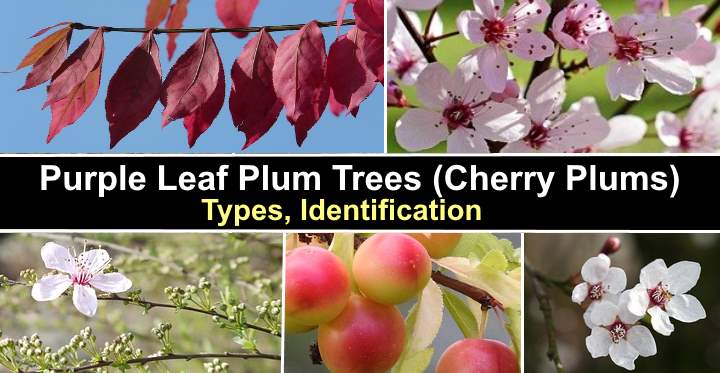
The purple leaf plum tree is a beautiful ornamental flowering tree with dark burgundy or purple leaves, fragrant whitish-pink spring blossoms, and an attractive shape. Also called the cherry plum tree, the purple leaf tree also produces small plum-like yellow or red edible fruit. In a garden landscape, the relatively small deciduous tree has many ornamental uses.
Purple leaf plum trees are ideal ornamental flowering trees for a garden landscape because of their colorful foliage with pointed, tooth-edged dark leaves. In spring, clusters of fragrant white or pink flowers produce spectacular floral displays. In winter, the tree’s spreading vase shape creates an attractive silhouette.
This article is a guide to the most eye-catching varieties of purple leaf plum trees. Descriptions and pictures of the tree’s purple or dark red leaves and dainty flowers will help you choose the best type for your yard. In addition, you will get handy tips on growing purple leaf plum trees.
What is a Purple Leaf Plum?
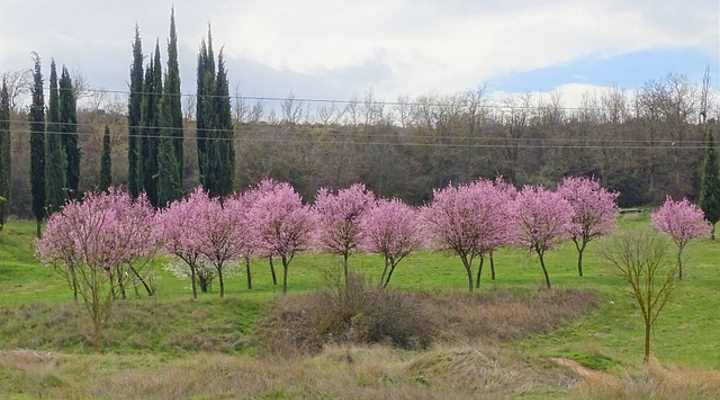
Purple leaf plum trees (Prunus cerasifera) are beautiful ornamental flowering trees in any landscaped garden
The purple leaf plum tree (Prunus cerasifera) is a small shrub-like ornamental tree with reddish-purple leaves, early spring blossoms, and edible cherry-like plums. The small tree with dark purple leaves grows between 15 and 25 ft. (4.5 – 8 m) tall. The deciduous tree has dense foliage and a vase-shaped crown.
The cherry plum flowering tree thrives in USDA zones 4 through 9. The easy-to-grow landscape tree grows best in moist but well-drained soil that is moderately fertile. The attractive dark foliage tree performs well in full sun and can tolerate some shade. However, too much shade causes the leaves to turn green.
The small to medium-sized purple leaf plum tree has a moderate growth rate. You can expect the tree to grow between 12” and 24” (30 – 60 cm) per year. A cherry plum tree averages around 20 ft. (6 m) in height when it’s fully mature.
A purple leaf plum tree tends to be a messy tree because it produces an abundance of round red or yellow fruits that drop from July to September. The edible round drupes attract wildlife but can cause a mess on driveways, sidewalks, or walkways.
The purple cherry plum tree has a short life span. Even in ideal conditions, the small tree only lives for 20 years or so. However, the tree’s beautiful pink or white spring blossoms and shrub-like growth make it popular for growing as a specimen tree, foundation planting, flowering hedge, or privacy screen.
Types of Purple Leaf Plum
Purple leaf plum tree ‘Thundercloud’—The cherry plum tree has a rounded shape, light pink flowers, and deep red and purple leaves. This is one of the most popular purple plum leaf trees.
Ornamental purple leaf plum tree ‘Nigra’—The cherry plum ‘Nigra’ tree has showy light pink blossoms and dark purple, almost black leaves. The purple-leaved tree sometimes produces yellow or red plums.
Purple leaf cherry plum tree ‘Atropurpurea’—Purple or red leaves and bright pink fragrant flowers are the attractive features of this purple leaf plum tree.
Flowering purple leaf plum tree ‘Purple Pony’—The dwarf variety of cherry plum tree grows up to 12 ft (3.6 m) tall and wide and features dark purple leaves.
Purple leaf plum tree ‘Newport’—This low-branching, spreading cherry plum tree has dark purple leaves that turn red in the fall.
Purple leaf plum tree ‘Krauter Vesuvius’—The cherry plum tree features dark reddish-purple foliage, abundant showy whitish-pink blossoms, and edible, burgundy-colored round plums.
Purple Leaf Plum Flowers
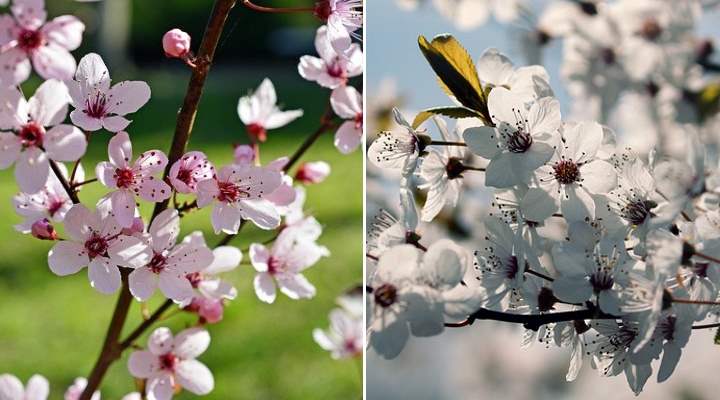
Purple leaf plum flowers
Flowers on purple leaf plum trees are usually the first to appear in spring. The single small pink or white flowers grow in dense clusters, covering the beautiful tree in bright colors. Each attractive, fragrant flower has five petals growing in a radial form measuring 1” (2.5 cm) across.
Purple Leaf Plum Bark
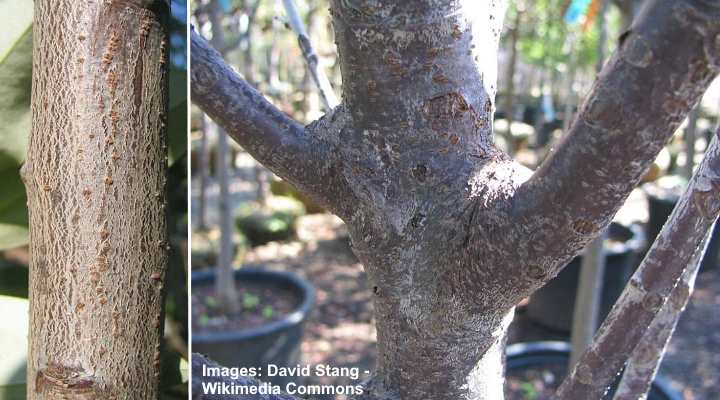
Purple Leaf Plum Bark
Bark on purple leaf plum trees is smooth reddish-brown or gray. The tree’s bark features horizontal lenticels like many cherry trees. As the purple leaf plum tree matures, the thin bark becomes fissured with shallow, irregular ridges. Twigs tend to be an attractive dark grayish or reddish-brown color.
Purple Leaf Plum Tree Leaves

Purple leaf plum tree leaves
Purple leaf plum tree leaves are pointed ovate leaves with serrated margins and a deep red or rich purple color. The dark leaves have fine hairs on the underside. Leaves usually appear red in spring and turn dark during the growing season. Purple leaf plum tree leaves measure up to 3” (7.5 cm) long.
Purple Leaf Plum Fruit
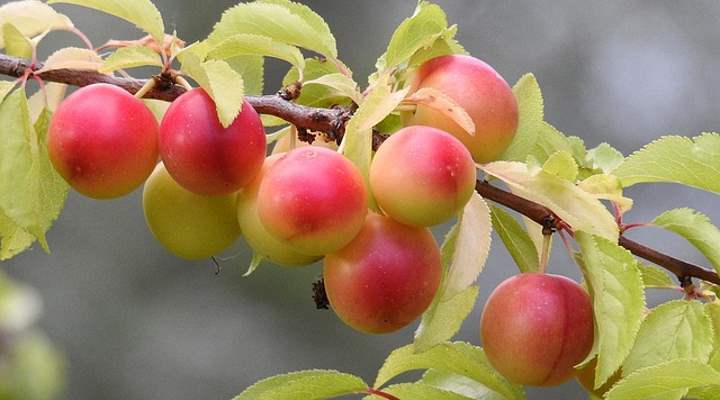
Purple leaf plum fruit
Fruit on purple leaf plum trees is round yellow or red drupes that are juicy plums. The tiny edible plums measure 0.8” to 1.2” (2 – 3 cm) in diameter. The taste of plums from purple leaf trees is described as sweet and slightly acidic closer to the stone. The cherry plum fruits are typically ready from mid-July to mid-September.
Purple Leaf Plum Identification
The primary identifying feature of purple leaf plum trees is their dark foliage with leaves that can be shades of dark burgundy to deep purple. Purple leaf plum trees are also identified by their cherry blossoms in the spring, small round yellow or red plums, and a rounded vase-shaped crown.
Types of Purple Leaf Plum Trees (with Pictures)
Let’s look in more detail at some of the most spectacular blossoming cherry plum trees that you can plant in your garden.
Flowering Purple Leaf Plum ‘Thundercloud’ (Prunus cerasifera ‘Thundercloud’)
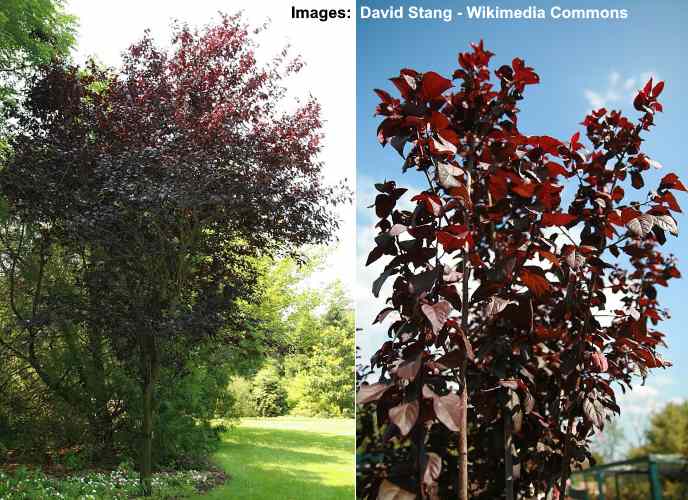
Prunus cerasifera ‘Thundercloud’
The purple leaf plum ‘Thundercloud’ tree is a purple-leaved, medium-sized tree with whitish-pink five-petalled beautiful flowers, small round purple plums, and an upright spreading crown. The ‘Thundercloud’ plum tree grows 15 to 25 ft. (4.5 – 7.6 m) tall and wide.
‘Thundercloud’ purple leaf plum tree leaves emerge ruby red and turn dark purple throughout the season. The deciduous, ovate leaves grow alternately in a simple arrangement. The purple leaves measure 2.5” (6 cm) long and have serrated margins.
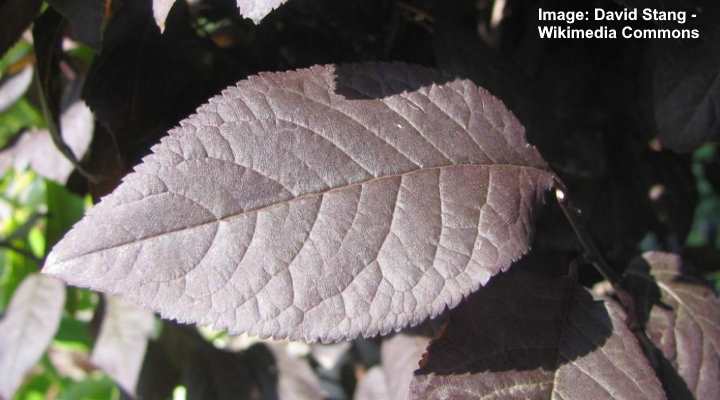
Prunus cerasifera ‘Thundercloud’ leaf
Other identifying features of the purple-leaved ‘Thundercloud’ tree are thin reddish-brown smooth bark, white or pink showy flowers, and a spreading habit.
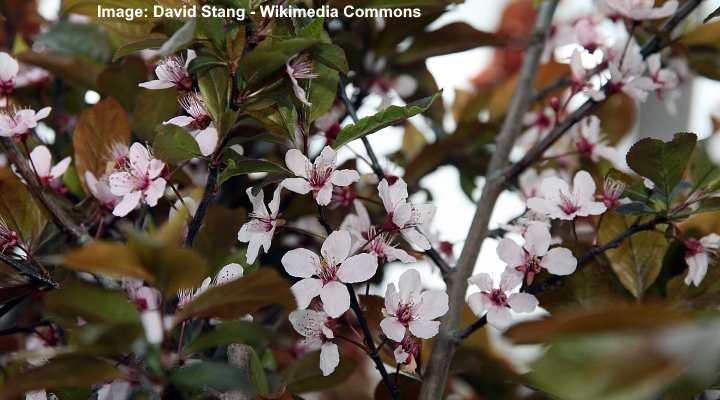
Prunus cerasifera ‘Thundercloud’ flowers
The ornamental cherry plum ‘Thundercloud’ also has the name Myrobalan plum tree.
The ‘Thundercloud’ tree has some of the darkest purple leaves, branches, and twigs from all the purple leaf plum trees. This tree has medium growth and is one of the most popular plum trees to plant as a landscape specimen.
Purple Leaf Plum ‘Nigra’ (Prunus cerasifera ‘Nigra’)
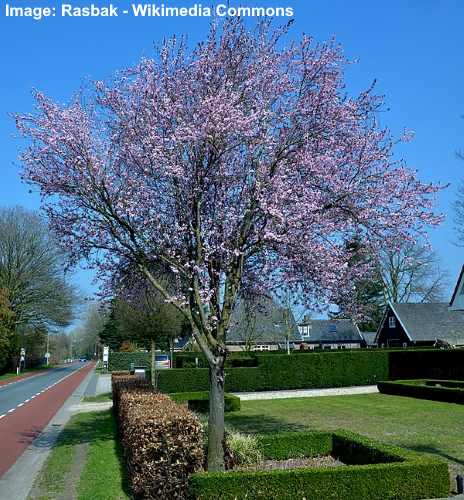
Prunus cerasifera ‘Nigra’
The purple leaf cherry plum ‘Nigra’ tree is identified by its rounded crown of dark purple, almost black leaves. The tree’s pale pink flowers emerge from pink buds and blossom into showy, fragrant five-petalled flowers. The bright pink flowers have a deep pink center and protruding white stamens.
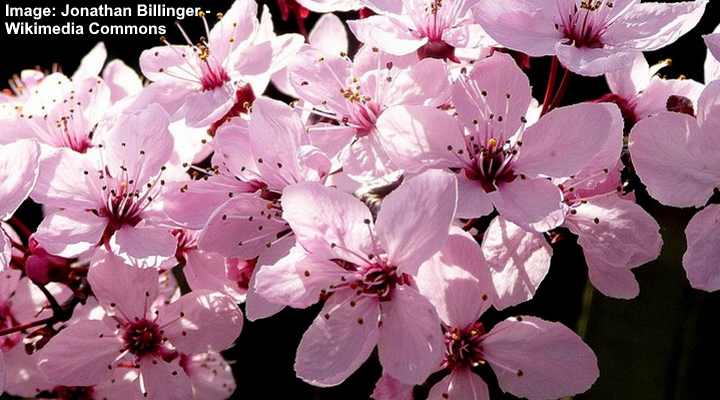
Prunus cerasifera ‘Nigra’ flowers
The ‘Nigra’ purple leaf plum tree grows between 15 and 20 ft. (4.5 – 6 m) tall and wide. The plum tree’s recognizable pyramidal crown looks stunning when bronze leaves emerge in spring, then gradually turn almost black before becoming red in the fall. Then, in late summer, the red or yellow edible plums are ready to eat.
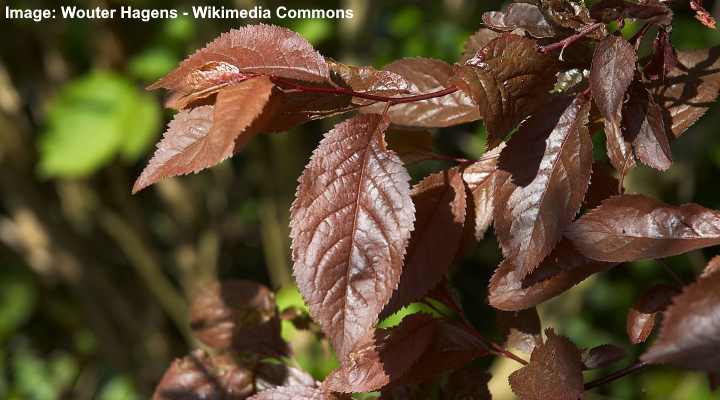
Prunus cerasifera ‘Nigra’ leaves
The ‘Nigra’ purple leaf plum tree variety thrives in full sun and moist soil. Tolerant of a range of soil types, the ‘Nigra’ plum tree is easy to grow in a garden landscape.
Plant the Prunus cerasifera ‘Nigra’ as a specimen lawn tree. However, with the proper pruning, the flowering shrub-like tree grows as a hedge, living fence, or privacy screen.
Flowering Purple Leaf Plum ‘Atropurpurea’ (Prunus cerasifera var. Atropurpurea)
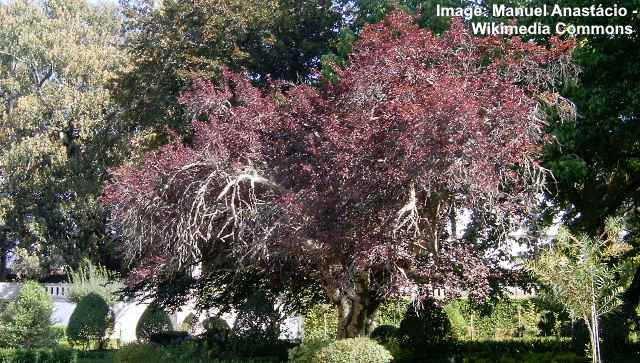
Prunus cerasifera var. Atropurpurea
The purple leaf plum ‘Atropurpurea’ is an attractive ornamental tree with showy white flowers, reddish-purple leaves, and reddish-brown fruit. The flowering cherry plum tree has a rounded vase-shaped crown consisting of ovate leaves with toothed margins. This small to medium-sized tree grows 15 to 25 ft. (4.5 – 7.6 m) tall and wide.
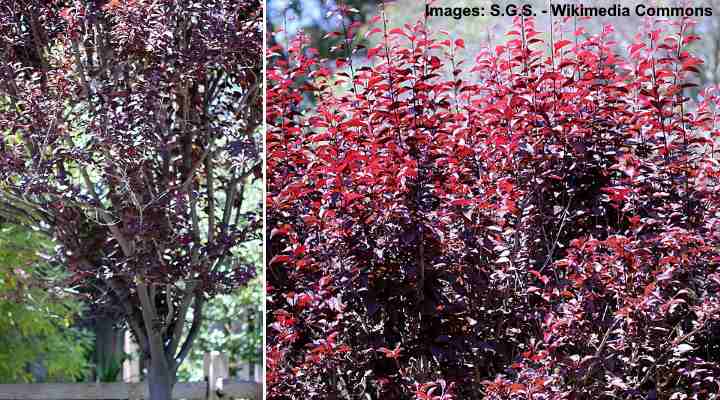
Prunus cerasifera ‘Atropurpurea’ foliage
Also called the pissard plum, the ‘Atropurpurea’ cherry plum tree is a fast-growing flowering tree that grows well in acidic soil or alkaline soil. To ensure dark coloration on the leaves, grow the tree in full sun and moist garden soil. This easy-grow specimen tree is relatively tolerant of drought once established.
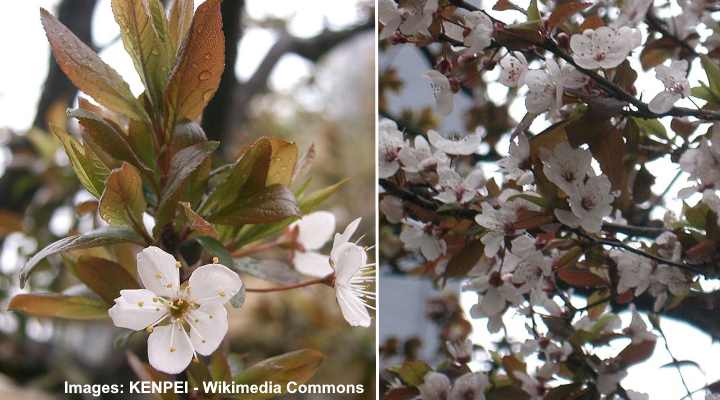
Prunus cerasifera ‘Atropurpurea’ flowers
Some identifying features of the ‘Atropurpurea’ purple leaf plum tree are its dark brown fissured bark, reddish-brown branches, small edible plums, and showy white, five-petalled flowers.
Ornamental Purple Leaf Plum ‘Purple Pony’ (Prunus cerasifera ‘Purple Pony’)
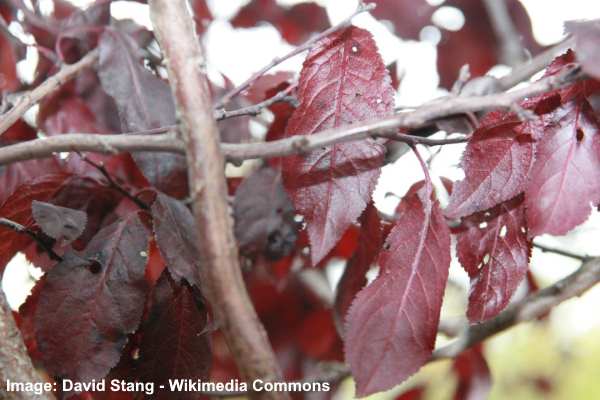
Prunus cerasifera ‘Purple Pony’
The purple leaf plum ‘Purple Pony’ tree is a decorative dwarf flowering tree with deep purple leaves, pale pink bowl-shaped flowers, and smooth reddish-brown bark. Suitable for small, compact gardens, this dwarf plum tree grows 10 to 12 ft. (3 – 3.6 m) tall and wide.
Like all purple leaf plum trees, dark foliage is this tree’s attractive feature. The small pointed ovate or egg-shaped leaves are smaller than other cherry plum trees. The pale pink, scented showy flowers measure 1” (2.5 cm) across. However, unlike the larger purple leaf plums, this miniature tree doesn’t produce fruit.
The ‘Purple Pony’ cherry plum tree has a rounded, spreading crown. With the proper care, the decorative tree can grow as a foundation planting, compact, dense privacy hedge, or container tree.
Purple Leaf Plum ‘Newport’ (Prunus cerasifera ‘Newport’)
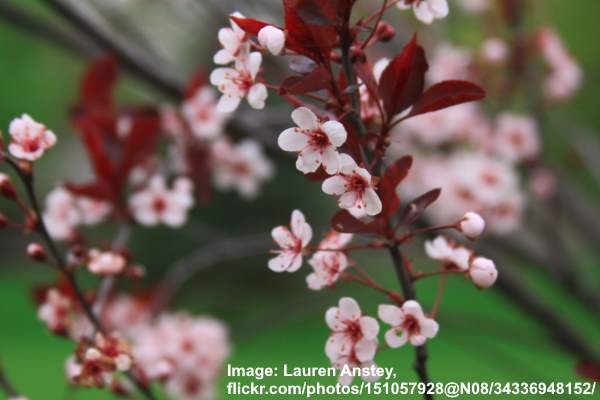
Prunus cerasifera ‘Newport’
The spectacular ‘Newport’ purple leaf plum tree features dark reddish-purple leaves, tiny pale-pink blossoms, and small edible drupes. The cherry plum cultivar has an identifiable pyramidal to rounded crown, purple foliage, and small dark red fruits. This specimen tree grows 15 to 20 ft. (4.5 – 6 m) tall and wide.
The serrated elliptic leaves emerge on branches in spring as light bronze-purple blades. The foliage gradually darkens to dark purple throughout the season before turning an attractive red color in the fall. Each purple leaf measures 2.5” (6 cm) long from the petiole to its apex
The ‘Newport’ purple leaf plum tree stands out from the other cherry plums due to its attractive purple foliage.
Purple Leaf Plum ‘Krauter Vesuvius’ (Prunus cerasifera ‘Krauter Vesuvius’)
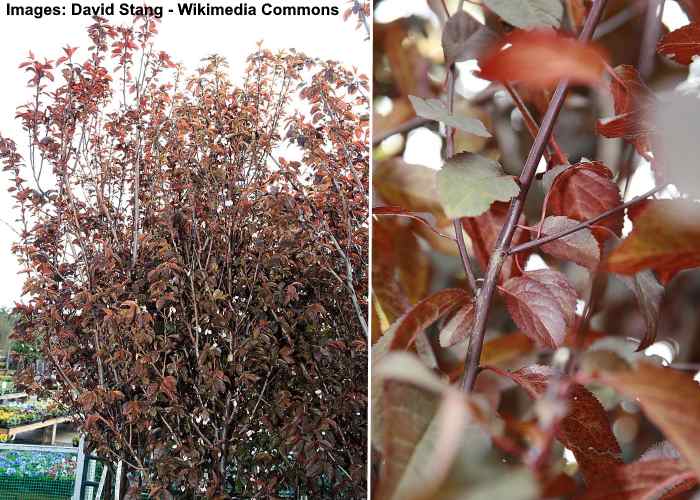
Prunus cerasifera ‘Krauter Vesuvius’
The ‘Krauter Vesuvius’ cherry plum has a beautiful spreading vase crown, deep red leaves that turn dark purple, and pale pink flowers that cover the tree in spring. The pink plum tree flowers appear on bare branches, creating a spectacular display. Small red leaves then appear, creating a stunning contrast with the whitish-pink flowers.
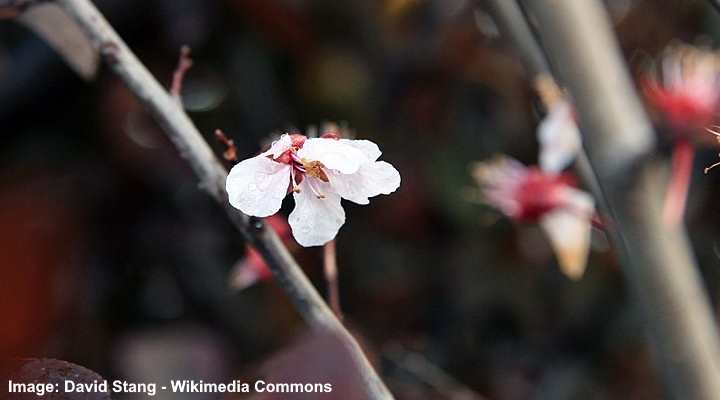
Prunus ‘Krauter Vesuvius’ flower
The cherry plum ‘Krauter Vesuvius’ grows 15 to 20 ft. (4.5 – 6 m) tall and is prized for its attractive dark purple foliage. The deep purple leaves keep their color throughout the growing seasons.
Visually, the ‘Krauter Vesuvius’ purple leaf plum is similar to the popular ‘Thundercloud’ tree. The only difference is that the ovate leaves on the ‘Krauter Vesuvius’ cultivar emerge a brighter red color.
How to Grow Ornamental Purple Leaf Plum
Purple leaf plum trees are decorative flowering trees suitable for front or backyards. Most trees thrive in USDA zones 5 to 8, although some cultivars are winter hardy in zone 4. The flowering plum trees, with their purple leaves, are relatively easy to maintain. Most plum trees tolerate temperatures as low as 0°F (-17°C).
Where to Plant Purple Leaf Plum
Grow a purple leaf plum tree in the sunniest spot in your garden. Ideally, the cherry plum tree needs at least six hours of sunlight daily to maintain its deep purple foliage. Although the purple leaf tree tolerates some shade, more than two hours of shade every day may cause the dark leaf coloring to fade.
Plant the purple leaf plum tree in loamy soil or sandy soil that is well-drained. Typically, average garden soil without amendment is ideal for healthy growth. The planting location should be moderately fertile. The only soil type that can negatively impact the tree’s health is compacted soil with poor drainage.
How to Care For Ornamental Purple Leaf Plum Trees
A purple leaf plum tree is easy to care for. The tree blossoms with stunning white or pink flowers and grows dark purple leaves. However, there are a few things to consider for ensuring the tree’s good health.
How to Water Purple Leaf Plum Trees
Purple leaf plum trees grow best when the ground is consistently moist but not soggy. You may have to water the garden soil twice a week during the growing season to keep it moist. In fall and winter, watering twice a month should be sufficient.
Purple leaf plum trees are moderately drought tolerant. So, if there is sufficient rainfall, you can water the dark-leaved tree less frequently. However, during spells of high heat, you may have to water the ground more often.
Top tip for watering purple leaf plum trees: Always deeply water the root area to ensure that the roots get sufficient moisture.
Pruning Purple Leaf Plum Trees
It’s not necessary to prune cherry plum trees extensively. However, some light pruning after the tree has finished flowering can help keep its shape and encourage dense growth. In the fall, you can remove any damaged, diseased, or dead branches to improve the tree’s appearance and health.
Fertilizer for Purple Leaf Plum Trees
Like most flowering trees, a purple-leaf plum tree benefits from some fertilization and extra nutrients. Cherry plums thrive in moderately fertile soil. So, adding an all-purpose fertilizer with an NPK rating of 7-4-4 in spring can encourage healthy growth. Also, working in organic compost in spring can boost flowering and foliage development.
Related reading: The best fertilizers for your garden trees.
Pests and Diseases Affecting Purple Leaf Plum Trees
Purple leaf plum trees are prone to several types of pests. Some common garden pests to affect the tree’s growth include aphids, leafhoppers, caterpillars, scales, and tent caterpillars.
To get rid of aphids or leafhoppers, use a short sharp blast of water from a garden hose to dislodge the pesky insects.
Getting rid of caterpillars can be more problematic. For example, you know your purple leaf plum has problems with tent caterpillars if you see black fuzzy caterpillars and tent-like structures on the branches. Some ways of eradicating tent caterpillars include removing them by hand and destroying the nests, using neem oil solution, or a spray containing Bacillus thuringiensis (Bt).
Common diseases affecting purple leaf plum trees include leaf spot, cankers, gray mold, and verticillium wilt. The best way to resolve issues with diseased foliage is to remove damaged foliage and improve the tree’s growing conditions. Ensuring proper air circulation throughout the branches and using the correct watering techniques are usually enough to keep your flowering trees healthy.
Related articles:
- Types of Cherry Blossom Trees
- Dwarf Fruit Trees for Indoors or Outdoors
- Types of Small Flowering Trees
